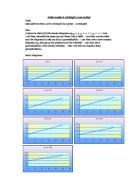As there are 2 methods of finding the approximate area numerically, one will be used to find the area under one curve and the other method will be used for the 2nd curve. The calculator will then be used to find the exact answer to each and hence it will be possible to asses which mothod produces the best results.
Finding the area under y =10SIN(0.08x)+25 by the trapezium rule
A fairly good approximation could be gained by dividing the line into 3 sections each 20m wide.
The formula
Area =½ width(h1+2h2+ .. +2hn-1+ hn)
= ½ x 20 (25 + 2 x 35 + 2 x25 + 15)
= ½ x 20 x 160 = 1600m2
As this curve is mostly concave, the area will be an underestimate, but it would have been more accurate if it had been divided up into more strips
But by the calculator the integral is 1614m2, so the error% is (1614-1600)/1614 x 100 =0.87% which is very small and in part due to the last 3rd of the curve being convex
Finding the area under y =10Scos(0.08x)+15 by the mid-ordinate rule
Again 3 divisions will be made giving:
The mid-ordinate coordinates are:
So the area is 20 x (22.07 + 7.93 + 7.93)
= 20 x 37.93 = 758.6 m2
The calculator foretold the area under this curve 775.5 m2 give an error % of
(775.5 – 758.6)/775.5 x 100 = 2.18%
which is a little worse ( which is not usual as the mid-ordinate rule uses the idea that the areas included that should not, largely cancel out those that were not included but should have been and therefore is better than the trapezium rule)
So the area of Trig Pond is 1600 – 758.6 = 841.4m2
Find the area of the pond by integration
Area =
=
=[(-125cos(4.8) + 1500) – (-125cos(0) ] – [(125sin(4.8) + 900)- (125sin(0))]
=(1489.06 + 125) – (775.48 – 0) = 1614.06 – 775.48 = 838.58 m2
Conclusion
Both numerical method gave a fairly close result to the calculus one, even though the number of divisions was not very large.







